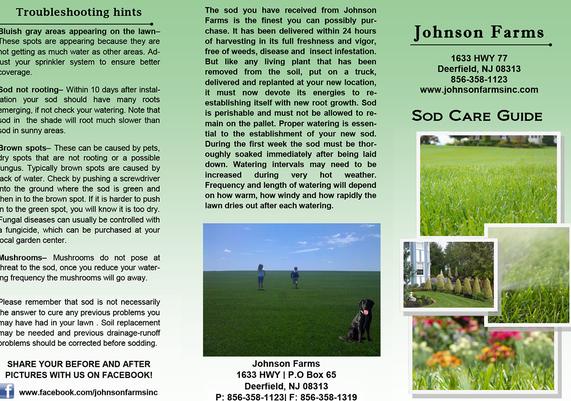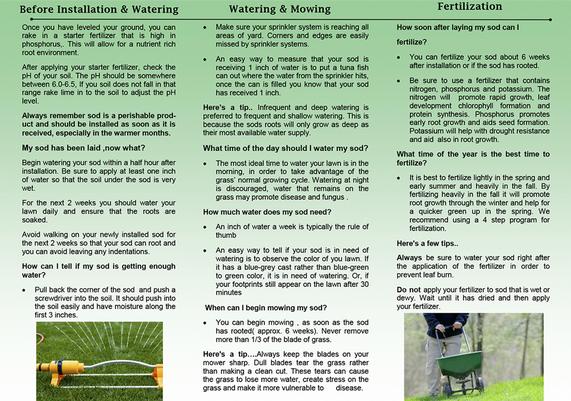
Sod Watering and Care
Watering
Water is essential to all life . . . too little water and we die, too much water and we drown. The same is true of the grass in our lawns. Water makes up 70% to 80% of the weight of grasses and the clippings alone are nearly 90% water. While most people are concerned about not watering their lawns enough, the fact is, more lawns are damaged by overwatering.
WHEN TO WATER
It is essential to begin watering new turfgrass sod within a half-hour after it is installed or placed on the soil. Apply at least 1 inch (2.5 cm) of water so that the soil beneath the turf is very wet. Ideally, the soil 6 inches (15 cm) below the surface will be moist.
Watering Tip # 1
Pull back a comer of the turf and push a screwdriver or other sharp tool into the soil. It should push in easily and have moisture along the first 6 inches (15 cm), or you need to apply more water.
Watering Tip #2
Make certain the entire lawn is receiving water. Comers and edges are particularly vulnerable to drying out and are easily missed by many sprinklers. These sections dry out faster than the center portion of a new lawn. Areas near buildings also dry out faster and may require more water.
Watering Tip #3
Runoff may occur on some solid or sloped areas before the soil is adequately moist. To conserve water and ensure even irrigation, tum-off the water if runoff begins. Wait 30 minutes to an hour and restart watering, repeat as needed. For the next two weeks ( or until the turf is well-rooted), keep the soil below the turf moist with daily ( or more frequent) waterings of approximately one-quarter inch (0.6 cm) each. Increased watering may be required during hot, dry or windy periods.
Watering Tip #4
As the roots of the turf begin to penetrate the soil, it will be difficult to pull back the comer to check beneath the turf to see if the water is penetrating the soil, but you can still use a sharp tool to check moisture depth by pushing it through the turf and into the soil.
Watering Tip #5
Water as early in the morning as possible to take advantage of the grass's normal growing cycle. Morning is ideal because of lower wind speeds and less water is lost to evaporation. Watering in the evening is discouraged because water remaining on the grass can promote disease and fungus.
Watering Tip #6
Infrequent and deep watering is preferred to frequent and shallow watering. Roots will only grow as deep as their most frequent available water supply. Deeply rooted grass has a larger "soil-water bank" to draw moisture from and this helps the grass survive drought conditions and hot weather that dries out the upper soil layer. During the remainder of the growing season, most lawns will do very well with a maximum of one inch of water a week from either irrigation or rainfall.
Soil conditions may dictate irrigation be applied in two settings, approximately two to three days apart. This amount of water is all that is required for healthy grass, providing it is applied evenly and wets the underlying soil to a depth of 6 inches (15 cm).
POST INSTALLATION CARE OF TURFGRASS
The following recommendations from The Lawn Institute will help you maintain a thick, healthy lawn after natural turfgrass sod has been installed:
FERTILIZER
The type and quantity of fertilizer required for your lawn will depend on your grass variety. Cool and warm season grasses vary as do their nutrient requirements. Check with your Extension Service, local nursery or lawn and garden professional to determine what type of fertilizer is best for your lawn.
MOWING
The turfgrass can be mowed when it is rooted. Be sure to remove no more than 1/3 of the grass blade. The actual height of the cut varies depending on whether the grass is a cool or warm season and the type of grass. Keep your mower blades sharp. Dull blades tear the grass blade instead of cutting it cleanly. These small rips in the turfgrass tissue can cause the grass to lose more water, increase irrigation needs, create stress, and make the lawn more vulnerable to diseases.
GRASS CLIPPINGS
Leave grass clippings. Contrary to popular belief, they do not cause thatch. (Thatch usually occurs only when turf is excessively fertilized and soil is compacted, cool and moist.) If you follow the 1/3 cutting rule grass clippings won't smother the grass plants. They will dry out and work their way down to the soil surface. These clippings return nutrients to the soil, resulting in less fertilizer use. They also cool the soil and help it retain water.
THATCH
Thatch is a layer of dead and decomposing plant tissue that forms above the soil. A thin layer (" to I' inch) is beneficial to a lawn. It protects plant crowns and reduces compaction. But if the layer gets too thick, water, air and fertilizer can't get through to the soil and grass roots. Runoff increases and dry spots appear. Or when it's wet, the thatch can remain saturated and suffocate roots. Thatch usually occurs on turf that bas been heavily fertilized, and is most common on poorly drained, compacted and acidic soils. Some species of lawn grasses are more prone to thatch problems than others. Severe thatch problems left unattended may eventually require the use of a dethatching machine. To prevent or minimize thatch problems, core aeration is an option depending on your situation.
AERATION
Core aerators punch small holes in the lawn allowing air and moisture to penetrate through the holes. It is most effective in late summer when temperatures are starting to cool and the soil is only slightly moist. After aeration, leave the soil cores on the surface to dry. Then rake them to distribute the soil down through the grass to mix with and dilute the thatch. The mixing action of core aeration is similar to that provided by earthworms. Core aeration can also help increase water infiltration on compacted soils. Contract with a local landscape company for dethatching or core aeration service or check with your local equipment rental center.
How to Water
Proper watering techniques are important. Here are several helpful suggestions:
Avoid hand watering because it cannot provide uniformity. The only possible exception to this guideline would be the need to water the surface of the grass to cool it, or to provide additional water near buildings or other heat-reflecting surfaces. Understand each sprinkler bas its advantages and disadvantages. Proper use is determined by the type of sprinkler you select.
IN-GROUND SYSTEMS require professional installation, routine adjustments and proper maintenance to be effective. The greatest mistake made in most in-ground systems is the "set it and forget it" philosophy that fails to account for changing seasonal water requirements to maximize turf growth or allows the system to operate following an adequate rain. Another frequent problem is when sprinkler heads get out of alignment and apply water to the sidewalk, street or house-siding, rather than to the lawn.
HOSE-END SPRINKLERS range in complexity, cost and durability, but are portable and can provide uniform and consistent coverage when properly placed and maintained. During the growing/watering season, perform routine maintenance to check for blocked outlets, leaking or missing gaskets and misaligned sprinkler heads.
Water uniformitycan be accomplished by simply using 4 to 6 empty flat bottom cans (tuna fish, cat food, etc.), a ruler and a watch.
STEP #1 Arrange cans at random distances from any sprinkler.
STEP #2 Run the sprinkler for a specific amount of time, or until there is at least a 1/2 inch of water ( 1.3 cm) in one can.
STEP #3 Measure the amount of water in each can. Some variation is expected, but a difference of25-30% or more between any two cans will require adjusting or relocating the sprinkler.
Watering difficult areas such as slopes and under trees requires special attention to achieve maximum coverage and uniformity. For Slopes refer to Watering Tip #3 on reverse side. For areas under and near trees you need to know the specific water requirements for trees as well as grass. Despite having deep "anchor" roots, trees take-up moisture and nutrients from the top six inches of the soil and compete with the grass for moisture. Watering sufficiently for the grass may, in some cases, result in the over-watering of some varieties of trees or too little water for other varieties. A common solution is not to plant grass under the dripline of trees, but rather use that area for perennial ground covers, flower beds or mulch beds.
How Much Water
The amount of water your lawn requires and receives will determine its overall health, beauty and its ability to withstand use and drought. Keep in mind that too much water can ruin a lawn just as fast as too little water. One inch (2.5 cm) a week is a watering "rule of thumb" (by rain or watering) suggested for most lawns; however, this will vary between different turf species and even among cultivars within a specie, seasonal changes and different soil types.
Look at your lawn to determine its water needs. Grass in need of water will have a grey-blue cast, rather than a blue-green or green color. Also, footprints will still appear after a half-hour or more on a lawn in need of water, while on a well-watered lawn, footprints will completely disappear within a few minutes. Inspecting your lawn frequently will help you determine its water requirements and avoid either over or under-watering. Water timers can help provide consistency and even be pre-programmed to turn on or off. Some timers measure the amount of time water flows through the device, while others measure the number of gallons used. Read the directions with the timer to determine how yours operates.
